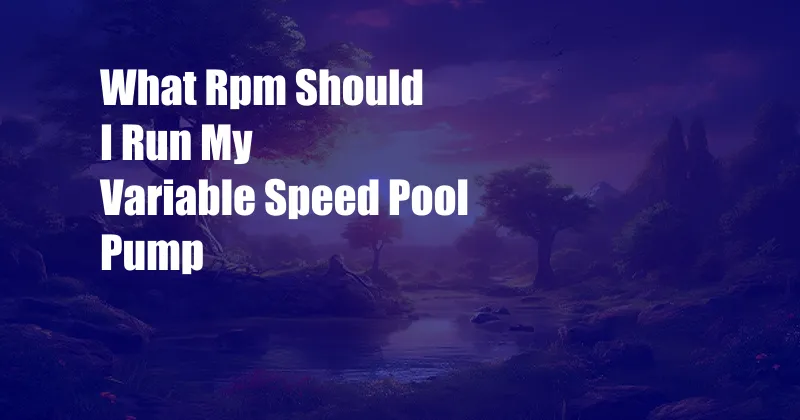
What RPM Should I Run My Variable Speed Pool Pump?
In the realm of pool maintenance, striking the optimal balance between energy efficiency and water quality is a constant pursuit. One crucial aspect of this balancing act lies in determining the appropriate RPM (revolutions per minute) at which to operate your variable-speed pool pump. Understanding the factors that influence this decision is key to maximizing your pool’s performance while minimizing energy consumption.
Your pool’s size, shape, and usage patterns are primary considerations when determining the ideal RPM for your pump. Larger pools with complex shapes or heavy usage demand higher RPMs to maintain proper circulation and filtration. Conversely, smaller pools with simpler shapes can often operate efficiently at lower RPMs. The type and quantity of filtration media also play a role; sand filters, for instance, typically require higher RPMs than cartridge filters.
Understanding the Consequences of Overpumping
Exceeding the recommended RPM for your pool pump can lead to a cascade of negative consequences:
- Increased energy consumption: Higher RPMs translate directly into higher energy usage, inflating your utility bills.
- Premature wear and tear: Overworking your pump accelerates wear and tear, potentially leading to costly repairs or premature replacement.
- Damage to pool components: Excessive water pressure can damage pipes, fittings, and other pool equipment.
Benefits of Low RPM Operation
On the other hand, operating your pool pump at low RPMs offers several advantages:
- Energy savings: Lower RPMs equate to reduced energy consumption, translating into lower utility costs.
- Extended lifespan: Operating your pump at lower RPMs minimizes wear and tear, prolonging its lifespan.
- Quieter operation: Pumps running at low RPMs generate less noise, creating a more tranquil poolside environment.
The Goldilocks Zone: Finding the Optimal RPM
Determining the optimal RPM for your variable-speed pool pump is a delicate balancing act, aiming to achieve the perfect harmony between energy efficiency and water quality. Factors such as pool size, filter type, and usage patterns must be carefully considered to arrive at the ideal setting.
As a rule of thumb, aim to run your pool pump at the lowest RPM that maintains proper circulation and filtration. Monitoring your pool’s water quality and adjusting the RPM accordingly ensures you find the sweet spot where energy savings and crystal-clear water coexist.
Tips and Expert Advice for RPM Optimization
- Consult a pool professional: Seek guidance from a qualified pool technician who can assess your pool’s unique characteristics and recommend the optimal RPM range.
- Use a variable-speed pump timer: Programmable timers allow you to customize your pump’s run times and RPM settings, further optimizing energy consumption.
- Monitor your pool’s water quality: Regularly test your pool’s water to ensure proper filtration and adjust the RPM as needed.
- Consider the seasons: Adjust your pump’s RPM based on seasonal variations in pool usage and water temperature.
- Don’t overfilter: Filtration beyond the recommended levels does not improve water quality but wastes energy.
Frequently Asked Questions about Pool Pump RPM
- Q: What is the ideal RPM range for most variable-speed pool pumps?
A: Typically, a range between 800-1200 RPM provides a good balance of energy efficiency and water quality.
- Q: How often should I adjust the RPM on my pool pump?
A: Monitor your pool’s water quality and adjust the RPM accordingly. Season changes and heavy pool usage may warrant adjustments.
- Q: Can running my pool pump at too low RPM damage my pool?
A: Yes, excessively low RPMs may compromise filtration and water circulation, leading to poor water quality and potential equipment damage.
Conclusion
Understanding the optimal RPM for your variable-speed pool pump is not merely a technical exercise; it’s about striking a delicate balance that maximizes energy efficiency, extends equipment life, and ensures a sparkling clean pool. By carefully considering your pool’s unique characteristics and following the expert tips outlined above, you can harness the power of variable-speed technology to achieve optimal pool performance at minimal cost.
Call to Action: Are you ready to optimize your pool’s performance and save energy? Contact a qualified pool professional today to determine the ideal RPM range for your variable-speed pool pump and enjoy the benefits of crystal-clear water and reduced utility bills.